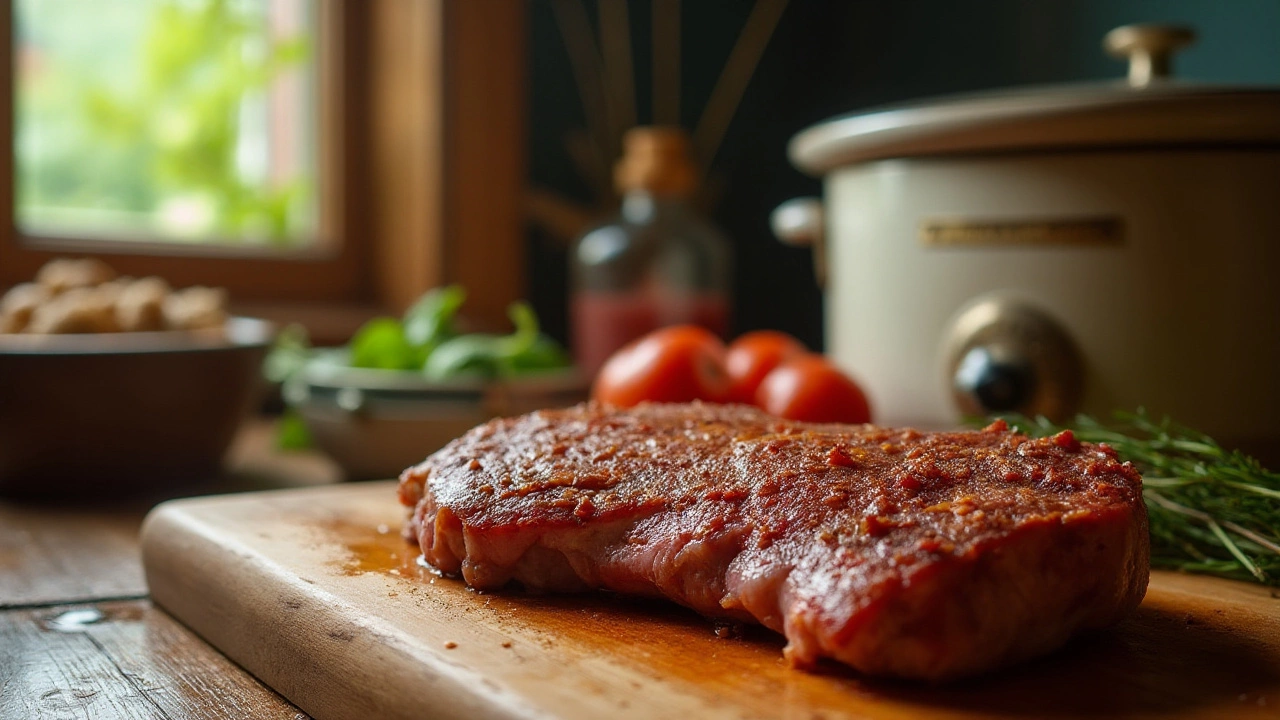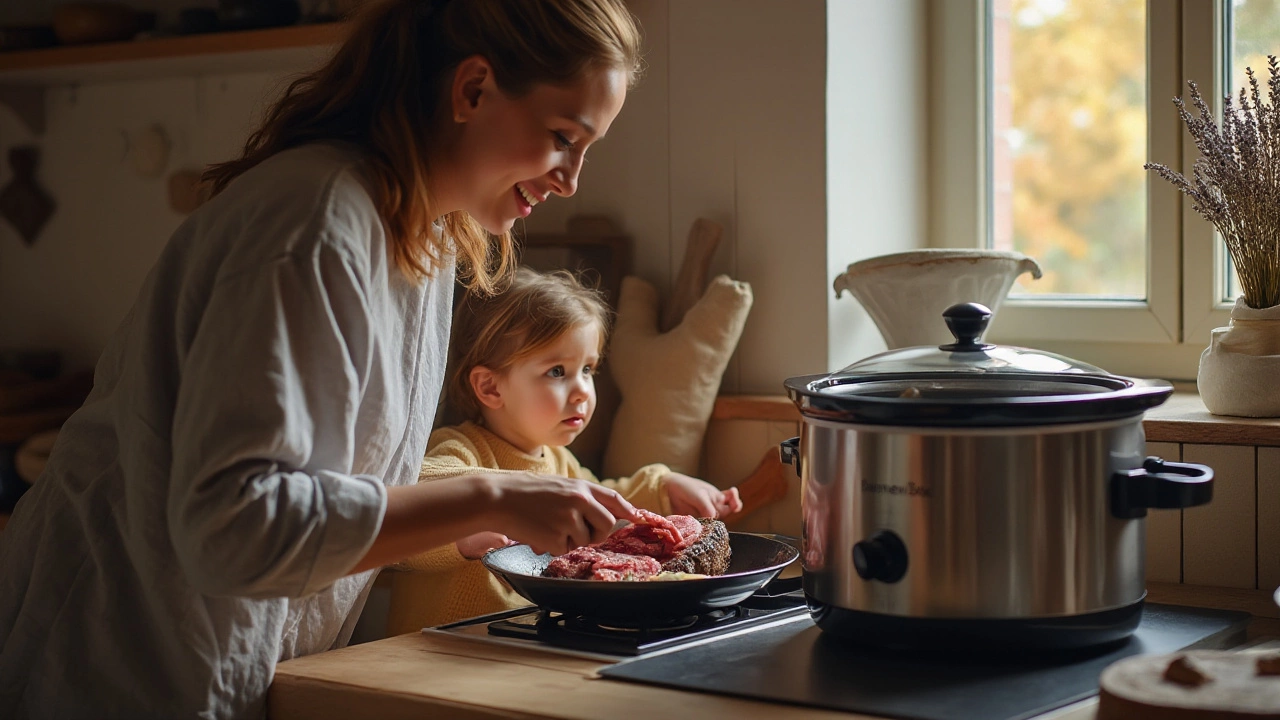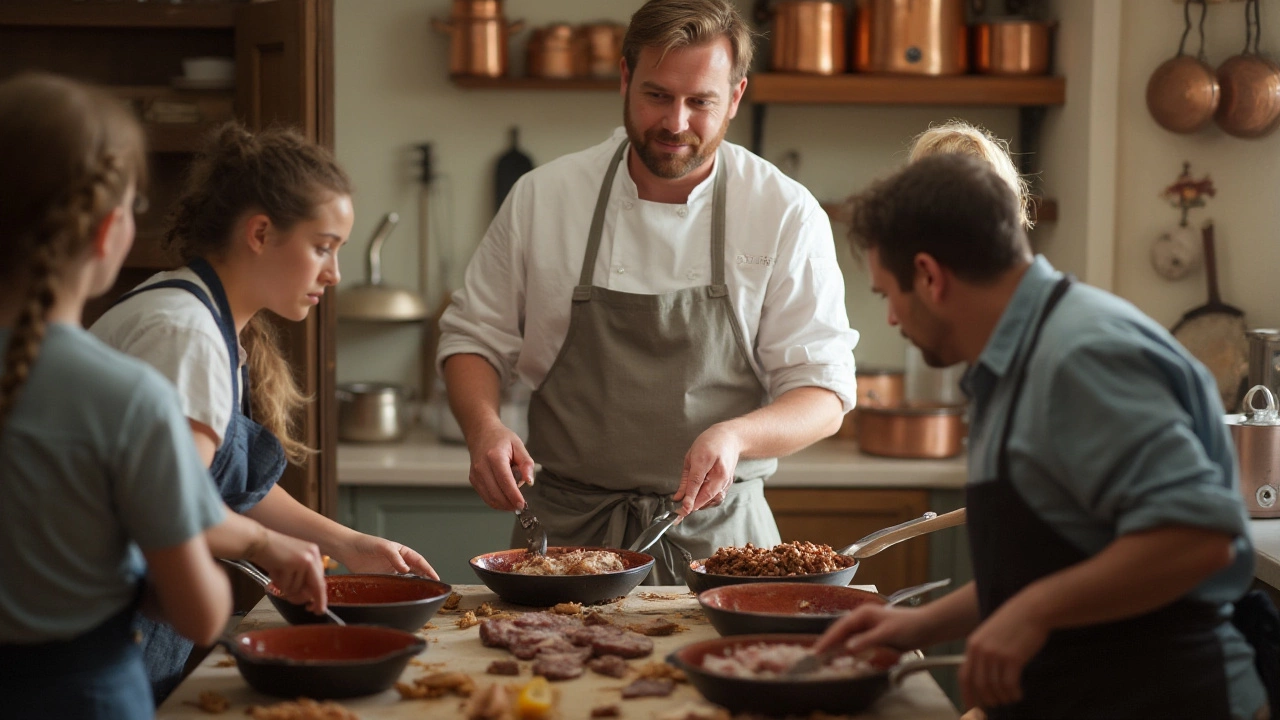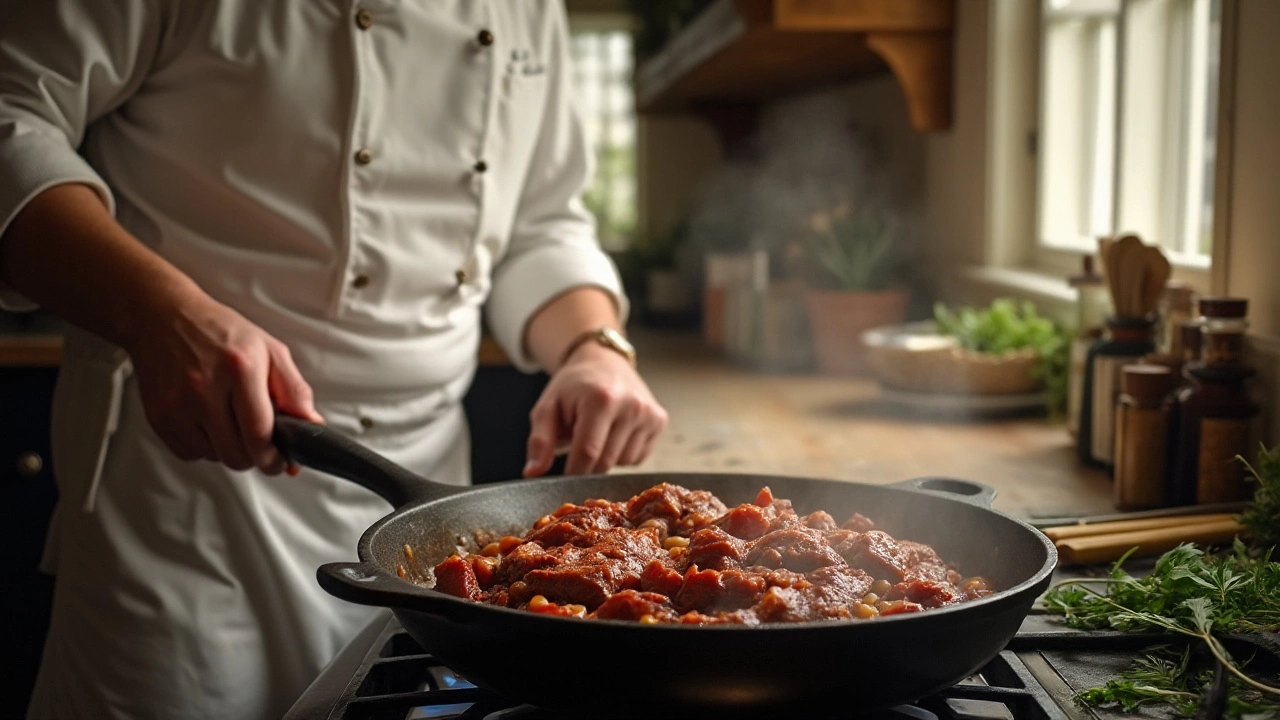Slow cookers are a saving grace for many home chefs, promising tender meats and deep flavors with minimal effort. Yet there's a choice to be made before tossing ingredients into your Crockpot: should you brown the meat first? This question has fueled kitchen debates far and wide.
Some cooks swear by browning as a crucial early step, insisting it brings out the meat's rich flavors and creates a savory foundation for your stew. Others find this step unnecessary, especially when time is short, and argue that the slow cooker can do the job on its own.
It's true that browning meat not only enhances flavors but also helps improve texture through a chemical reaction known as the Maillard process. Adding that initial sear can up your cooking game, transforming your stew into a culinary masterpiece. Yet, it’s equally valid to skip this step in favor of simplicity without sacrificing too much on taste.
Here, we dive into the reasons for and against browning, ensuring you're well-equipped for your next slow-cooker session. Whether you seek a quick-and-easy dinner or a gourmet meal, understanding the nuances of pre-slow-cook browning can elevate your culinary skills.
- Why Browning Might Be Beneficial
- Situations Where Skipping Browning Works
- Tips for Properly Browning Stew Meat
- Recipes That Benefit from Browning
Why Browning Might Be Beneficial
The process of browning meat before placing it in a slow cooker like a Crockpot can significantly enhance your culinary creation. This step, often overlooked by time-crunched home cooks, initiates the Maillard reaction. This chemical process isn’t just a fancy term scientists use to sound important; it’s the key to unlocking deeper, more complex flavors that can elevate your stew from ordinary to extraordinary.
When you apply heat to browning meat, the exterior undergoes a transformation. It turns a golden-brown color that isn’t just visually appealing; this change represents the development of numerous flavor compounds. These compounds contribute to a more robust, savory taste that simply wouldn’t be possible by slow cooking alone. Imagine the difference between a boiled piece of meat, bland and pale, versus one with a rich seared crust—it's an entirely different dining experience.
In addition to flavor, texture plays a crucial role in why browning could be beneficial. The sear creates a slightly crispy outer layer, adding a contrast that can be lost during the slow cooking process where tenderness reigns supreme. This balanced texture diversity can make each bite of your stew more interesting and satisfying.
To fully understand the benefits, consider what acclaimed chef J. Kenji López-Alt points out:
"Browning does more than make a crusty exterior. It improves the meat’s ability to hold onto juices during cooking and makes a dish more visually appealing—both crucial in creating restaurant-quality results at home."This insight underscores that browning isn't just about taste; it's about creating a comprehensive sensory experience that includes smell, taste, and sight.
For those intrigued by the scientific backbone of cooking, here’s a bit of detail: the Maillard reaction occurs between amino acids and sugars, developing complex and layered flavors. This interaction happens optimally when meat is cooked over high heat, which is why ensuring your pan or skillet is properly pre-heated is essential.
Moreover, browning can be particularly beneficial for certain recipes that aim to build depth and complexity. Cuisines that rely heavily on spiced broths or reduced sauces, such as French beef bourguignon or a rich Irish stew, benefit tremendously from that initial sear. The fond—those browned bits left in the skillet—is a treasure trove of flavor that can be deglazed with a bit of broth or wine, integrating perfectly into your dish.
So, while it might add an extra step to your cooking process, consider the multifaceted advantages that browning can bring. Not only does it result in a more flavorful and texturally pleasing meal, but it also provides an opportunity to engage with the art of cooking in a fulfilling way, transforming a simple stew into a dish with restaurant-level finesse.

Situations Where Skipping Browning Works
Browning meat before dropping it into the slow cooker is not always a necessity. In fact, there are scenarios where skipping this step might be a more practical choice. Imagine it's a busy weekday morning, and you're juggling breakfast, packing lunches, and attempting to get out the door before rush hour kicks in. Taking a moment to brown your stew meat could be the difference between chaos and sanity. In such a situation, skipping browning allows you to quickly assemble the ingredients, turn on your Crockpot, and let it work its magic throughout the day while you go about your routine.
Another circumstance in which browning might be omitted is when you are using particularly tender cuts of meat. Some premium slow-cooker aficionados assert that lean cuts do not need the browning phase, as their flavors and textures are already delightful without the caramelization. Instead, they suggest focusing on the aromas of fresh herbs or adding bold spices to the mix. This results in a dish where the seasoning shines without the added richness that browned meat presents.
It's also worth considering if you're planning on cooking for a large group, where the quantity of meat means you would need to brown in multiple batches. This can quickly become time-consuming. Adding the unbrowned stew meat straight to the slow cooker can significantly reduce prep time, allowing you to focus on other elements of your menu. This is especially fitting if your recipe includes flavorful liquids, like robust broths or thick red wines, which can deepen the dish’s profile without requiring pre-browned meat.
For dishes where lighter, brighter notes are favored over deep savor, such as certain poultry stews or veggie-packed recipes, skipping browning can keep those flavors crisp and distinct. Here, the slow simmering process brings out the natural sweetness of vegetables and allows the intrinsic flavors of the ingredients to take center stage. As culinary expert Harold McGee once said, "Browning rewrites the flavor story." Leaving it out can sometimes preserve the original script, keeping subtle flavors intact.
In summary, though browning can add a layer of depth to your meal, there are plenty of instances where you would intentionally leave it out. Recognizing when to skip this step can simplify your cooking process, save you time and effort, and still result in delicious, satisfying dishes. Whether you're under time constraints or adjusting your flavor profile, knowing when it's beneficial to forego browning offers flexibility that's key to enjoyable home cooking.

Tips for Properly Browning Stew Meat
To truly elevate your stew recipes, mastering the art of browning your meat is essential. The golden crust that forms when browning meat is a result of the Maillard reaction, a magical melding of science and flavor, giving depth and richness to your dish. Begin your culinary venture with a sturdy cast-iron skillet, known for its ability to hold and evenly distribute heat. This ensures every piece of meat is browned to perfection. Before you even start searing, make sure that your meat is patted dry. Any excess moisture will cause steaming instead of browning, leading to a less desirable outcome.
Seasoning is your next consideration. A simple rub of salt and pepper is often enough to enhance natural flavors without overpowering them, letting the meat shine on its own merits. Heat the pan over medium-high until it is shimmering. Here, patience pays off—putting the meat in too early might inhibit the crust formation. Place the meat in the pan, ensuring not to overcrowd it; this might require working in batches, but it’s worth the extra time. Crowded memories will steam rather than sear, jeopardizing your ambition for that perfect browning. Allow each side a few minutes without interference; repeated turning will prohibit the crust from developing.
Listen closely, for the sound of the sizzle is your ally. It tells you the magic science is in action beneath that hot surface. When ready, use tongs to flip the meat only once per side. Unique knowledge from experienced chefs tells us to avoid completely cooking the meat during browning; a gentle sear is enough as the slow cooker will take it the rest of the way. Once browned, promptly transfer the meat to your slow cooker, now ready for the long, slow bath of flavors in Crockpot cooking.
"Browning meat creates a deep, savory taste that builds a great base for any dish," says renowned chef Julia Child, emphasizing the importance of this process. Not only does it improve flavor, but it also influences the color and visual allure of the final dish.
There’s room for experimenting with each browning session. Consider adding minced garlic or chopped onions to the pan in the last minute—let them sauté alongside your browned meat. The aroma is captivating, setting the stage for an aromatic symphony within your slow cooker. Chefs with a penchant for varied flavors dare to deglaze the pan with wine or broth once the meat is removed, scraping up the flavorful browned bits left behind. This liquid gold can be a beautiful addition poured over the meat when it enters the Crockpot. These creative touches can further personalize your stew, leaving an imprint of your culinary journey in each bite.

Recipes That Benefit from Browning
Not every Crockpot dish demands the extra step of browning, but several recipes truly shine when you begin with a seared surface. Take, for instance, the classic beef stew. The robust flavors that develop as the beef cubes achieve a rich, caramelized crust are unmatched. This technique is not just for beef. Whether you are preparing a hearty lamb stew or a comforting chicken casserole, the browning meat step can be a game-changer, providing a layer of flavor complexity that can elevate even the most humble meat cuts.
Imagine you're crafting a savory beef bourguignon; skipping browning could mean missing out on the deep, complex backdrop of flavors that the dish is known for. The Maillard reaction, responsible for this transformation, won't only make the meat mouthwatering but also enhances the rich sauce that forms during slow cooking. For dishes relying heavily on meat as the flavor cornerstone, like a braised short rib, browning becomes vital. It essentially lays down a sumptuous taste foundation that carries throughout the long hours in the Crockpot, rewarding patience with irresistible savoriness.
According to culinary icon Julia Child, “Opening a can of soup is not cooking.” This notion can be extended to the value of thoughtfully browning meat to unlock its hidden depth. Respect this process as part of the intricate layers of cooking that slow cookers might not achieve entirely by themselves. Taking this step with meats before they simmer not only enriches the broth with delightful nuances but ensures that even the simplest ingredients reach their full potential.
Top Picks for Browning First
Let’s delve into specific recipes where the practice of browning can lead to culinary success. Coq au Vin, a French classic, benefits immensely from browned chicken. As the bird simmers slowly with aromatic vegetables and wine, the early sear keeps the meat flavorful and tender. Another notable dish is the unmistakable Texas chili con carne. Here, the browned ground meat provides a hearty base that lets the spices meld seamlessly, creating a symphony of flavors that slowly evolve in the Crockpot.
- Beef Stew: The classic slow cooker staple, enriched by browned beef.
- Coq au Vin: French sophistication that begins with browned chicken.
- Texas Chili Con Carne: Ground meat seared to anchor the fiery blend of chili spices.
- Braised Short Ribs: Luxuriously savory, benefiting from the initial sear.
Choosing recipes that could be enhanced by browning depends on personal taste and the time available. However, if you have the opportunity, allowing that extra time for a quick sear can transform ordinary meals into extraordinary culinary experiences. Your Crockpot might indeed handle the rest of the cooking, but you set the first glorious notes through this simple, yet skillful, step.

